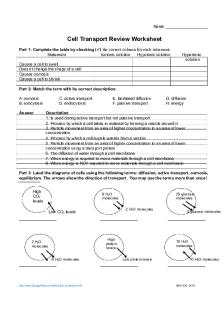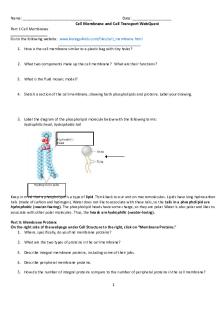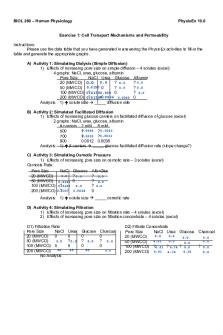4- Cell Transport Review PDF

| Title | 4- Cell Transport Review |
|---|---|
| Author | Crystal Jerrell |
| Course | Basic Anatomy and Physiology |
| Institution | Guilford Technical Community College |
| Pages | 4 |
| File Size | 241.5 KB |
| File Type | |
| Total Downloads | 96 |
| Total Views | 204 |
Summary
Download 4- Cell Transport Review PDF
Description
Cell Transport Review
Name ____________________________________ Section _______
A. Complete the table by checking the correct column for each statement. STATEMENT
ISOTONIC SOLUTION
HYPOTONIC SOLUTION
Causes cell to swell Doesn’t change cell shape Causes osmosis Causes cell to shrink
B. Matching. Match the term with its correct description. ___1. Transport protein that provides tubelike opening a. energy in the plasma membrane through which particles can diffuse. b. facilitated diffusion ___2. Is used during active transport but not passive transport. c. endocytosis ___3. Process by which a cell takes in material by forming a d. passive transport vacuole around it. ___4. Particle movement from an area of higher concentration e. active transport to an area of lower concentration. ___5. Process by which a cell expels wastes from a vacuole f. exocytosis ___6. A form of passive transport that uses transport proteins g. protein pump ___7. Particle movement from an area of lower concentration h. channel protein to an area of higher concentration. ___8. Protein that must change shape in order to transport particles. C. Matching. Match the term with its correct description. ___1. Diffusion of water through a cell membrane ___2. Movement of substances through the cell membrane without the use of energy ___3. Aids in moving substances across the cell membrane ___4. Energy is required to move materials across the cell membrane ___5. Molecules of one substance are dispersed evenly within another substance ___6. Membrane of a vacuole fuses with cell membrane and releases its contents to the outside of the cell ___7. Cell membrane forms around an external substance, usually enclosing it in a vacuole, to bring it into the cell ___8. Molecules move from areas of high concentration to areas of low concentration
a. transport protein b. exocytosis c. active transport d. passive transport e. endocytosis f. equilibrium g. osmosis h. diffusion
HYPERTONIC SOLUTION
D. Label the diagrams below using “diffusion, active transport, osmosis, or equilibrium”. The arrows show the direction of transport. Terms may be used more than once!
Osmosis. Complete the sentences for each scenario by studying the diagram for each. 1.
2.
3. 4.
a. Water will flow _________________________ . High 70% NaCl CO2 30% H2O levels 25% 95% NaCl 15% 4 H2O l l
Uses90% ATPNaCl 10% H2O 90%NaCl 15% 5% NaCl 12Uses H2O ATP l l
Water will flow _________________________ the a.a.a. Water Water will will flow flow _________________________ _________________________ . Hsince 2O the b. The cell will (burst OR shrink OR stay the32since same). 15 glucose solute is _______________ concentration outmolecules ofofthe water concentration is greater _______________ thecell. cell. b.[Circle Themolecules cell will (burst OR shrink OR stay the same). one]. Low High The cell will (burstOR ORshrink shrinkOR ORstay stay same). b. b. The cell will (burst thethe same). 25 H O 25 H O 2 one]. 2 [Circle sodium sodium l l l l
5. Name the type of solution inside the cells of each diagram (as compared to the solution outside of the cell) below choosing Hypo rtonic, or Isotonic. H2O
H2O
Cell
Cell
H2O Cell
Sucrose Sucrose
Sucrose
Cell membrane
8. Name the processes occurring in the following diagrams.
E. Multiple Choice. Please select the best answer. ___1. What kinds of molecules pass through a cell membrane most easily? A. large and hydrophobic, B. Small and hydrophobic, C. Large and polar, D. Monosaccharides such as glucose.
___2. Water passes quickly through the cell membrane because? A. the cell membrane bilayer is hydrophilic, B. water movement is tied directly to ATP hydrolysis (meaning, energy is required), C. it is a small, polar, charged molecule; D. it moves through aquaporins in the membrane. ___3. Carrots that are immersed in fresh water for several hours become stiff and hard. Similar carrots left ina 0.20 M salt solution become limp and soft. From this we can deduce that the cells of the carrots are: A. hypotonic to both fresh water and the salt solution, B. hypertonic to both fresh water and the salt solution, C. hypertonic to fresh water but hypotonic to the salt solution, D. hypotonic to fresh water but hypertonic to the salt solution, E. isotonic with fresh water but hypotonic to the salt solution. ____4. Which of the following statements correctly describes the normal tonicity conditions for typical plant and animal cells? . A. The animal cell is in a hypotonic solution, and the plant cell is in an isotonic solution, B. The animal cell is in an isotonic solution, and the plant cell is in a hypertonic solution, C. The animal cell is in a hypertonic solution, and the plant cell is in an isotonic solution, D. The animal cell is in an isotonic solution and the plant cell is in a hypotonic solution, E. The animal cell is in a hypertonic solution, and the plant cell is in a hypotonic solution. ____5. When a plant cell, such as one from a sunflower stem, is submerged in a very hypotonic solution, what is likely to occur? A. the cell will burst, B. the cell membrane will lyse, C. plasmolysis will shrink the interior, D. the cell will become flaccid (drooping through lack of water), E. the cell will become turgid (completely plump, full of water to capacity). ___6. An artificial cell containing a 30% salt solution was placed into a beaker containing a 90% salt solution. Which statement below correctly predicts what will happen to the artificial cell? A. the artificial cell will absorb water and increase in size, B. the artificial cell will first absorb water, then lose water and maintain their normal size, C. the artificial cell will lose water and decrease in size, D. the artificial cell will first lose water, then absorb water, and finally double in size. ___7. A patient has had a serious accident and lost a lot of blood. In an attempt to replenish body fluids, distilled water (equal to the volume of blood lost) is transferred directly into one of his veins. What will be the most probably result of this transfusion? A. It will have no unfavorable effect as long as the water is free of viruses and bacteria, B. The patient’s red blood cells will shrivel up because the blood fluid has become hypotonic compared to the cells, C. The patient’s red blood cells will swell because the blood fluid has become hypotonic compared to the cells, D. The patient’s red blood cells will shrivel up because the blood fluid has become hypertonic to the cells, E. The patient’s red blood cells will burst because the blood fluid has become hypertonic compared to the cells. ___8. A cell was poisoned by a substance that destroyed its mitochondria. Circle all of the cell processes listed that would be able to continue. A. osmosis, B. diffusion, C. facilitated diffusion, D. exocytosis, E. pinocytosis, F. phagocytosis. 9. If you are stranded on the ocean, why should you NOT drink salt water (a hypertonic solution)? Give your answer in terms of cell transport!...
Similar Free PDFs

4- Cell Transport Review
- 4 Pages

Cell Transport Review Worksheets
- 8 Pages

Cell Transport Activity
- 3 Pages

Cell Transport Lab Report
- 2 Pages

Cellular Transport Review 21
- 6 Pages
Popular Institutions
- Tinajero National High School - Annex
- Politeknik Caltex Riau
- Yokohama City University
- SGT University
- University of Al-Qadisiyah
- Divine Word College of Vigan
- Techniek College Rotterdam
- Universidade de Santiago
- Universiti Teknologi MARA Cawangan Johor Kampus Pasir Gudang
- Poltekkes Kemenkes Yogyakarta
- Baguio City National High School
- Colegio san marcos
- preparatoria uno
- Centro de Bachillerato Tecnológico Industrial y de Servicios No. 107
- Dalian Maritime University
- Quang Trung Secondary School
- Colegio Tecnológico en Informática
- Corporación Regional de Educación Superior
- Grupo CEDVA
- Dar Al Uloom University
- Centro de Estudios Preuniversitarios de la Universidad Nacional de Ingeniería
- 上智大学
- Aakash International School, Nuna Majara
- San Felipe Neri Catholic School
- Kang Chiao International School - New Taipei City
- Misamis Occidental National High School
- Institución Educativa Escuela Normal Juan Ladrilleros
- Kolehiyo ng Pantukan
- Batanes State College
- Instituto Continental
- Sekolah Menengah Kejuruan Kesehatan Kaltara (Tarakan)
- Colegio de La Inmaculada Concepcion - Cebu










